Physical Address
304 North Cardinal St.
Dorchester Center, MA 02124
Colitis-associated neoplasia
Crohn's disease
Confidence interval
Cytomegalovirus
Controlled radial expansion
Computed tomography
Endoscopic balloon dilation
Enterocutaneous fistula
Enteroenteric fistula
Electrolyte solution
Endoscopic mucosal resection
Endoscopic stricturotomy
Endoscopic submucosal dissection
Endoscopy treatment–associated stricture
Examination under anesthesia
Gastrointestinal
Inflammatory bowel disease
Ileocolonic anastomosis
Ileocolonic resection
Ileal pouch-anal anastomosis
Nasogastric tube
Nonsteroidal antiinflammatory drug
Over-the-scope clip
Procedure-associated complications
Primary sclerosing cholangitis
Pouch-vaginal fistula
Rectal-vaginal fistula
Tumor necrosis factor
Through-the-scope clip
Ulcerative colitis
The author is supported by the Ed and Joey Story Endowed Chair.
The natural history of Crohn's disease (CD) dictates that a vast majority of patients would develop stricture and/or fistula during the disease course, and eventually need surgery. Approximately 20%–25% of patients with ulcerative colitis (UC) would need colectomy for medically refractory disease or colitis-associated neoplasia (CAN). Restorative proctocolectomy and ileal pouch-anal anastomosis (IPAA) is the surgical treatment of choice for patients who UC or familial adenomatous polyposis who require colectomy. In the majority of patients with CD or UC, surgery is not a cure, and postoperative disease recurrence and complications are common, including stricture, anastomotic leak and sinus, fistula, and abscess.
Medical therapy plays a limited role in the treatment of stricture. While medical therapy may be effective in the management of perianal fistula, its role in the treatment of enteroenteric fistula, enterocutaneous fistula, rectal-vaginal fistula, and pouch-vaginal fistula is minimal. In addition, medical therapy has a minor role in the treatment of anastomotic stricture and anastomotic leak or sinus. This leaves room for endoscopic therapy in the management of preoperative and postoperative complications of CD or UC. Therefore, there is an evolving role of endoscopic management of complications of inflammatory bowel disease (IBD). In the past decade, endoscopic therapy has emerged as a valid alternative to medical and surgical therapy. Endoscopic therapy has been proven to be more effective than medical therapy while less invasive than surgical intervention in the treatment of mechanical complications, such as stricture. Endoscopic therapy can serve as a bridging treatment modality between the medical and surgical therapy. Therapeutic endoscopy in IBD, like ones in other parts of digestive system carries an increased risk for procedure-associated complications (PAC), as compared with diagnostic endoscopy.
The prevalence of colonoscopy-associated complications has been systemically studied. In a metaanalysis of 21 eligible studies, the investigators reported a pooled prevalence for postcolonoscopy perforation, bleeding, and mortality was 0.5/1,000, 2.6/1000, and 2.9/100,000 colonoscopies, respectively. Colonoscopy with polypectomy was associated with a perforation rate of 0.8/1000 and a postpolypectomy bleeding rate of 9.8/1000. The complication rate was lower for screening/surveillance than for diagnostic examinations. In general, the reported frequency of perforation from diagnostic colonoscopy ranged from 0.03% to 0.8%, and therapeutic colonoscopy, from 0.15% to 3%. Our study of 217,334 lower gastrointestinal (GI) endoscopy (IBD, N = 9518 and non-IBD, N = 207,816) from the Cleveland Clinic Health System, showed a rate of perforation of 18.91/10,000 procedures and 2.50/10,000 procedures for IBD and non-IBD endoscopy, respectively. We further analyzed the risk factors and outcome of 84 patients with IBD and non-IBD (colonoscopy N = 70; sigmoidoscopy, N = 6; ileoscopy, N = 6; and pouchoscopy, N = 2). The rates of perforation in colonoscopy, flexible sigmoidoscopy, ileoscopy via stoma, and pouchoscopy in IBD and non-IBD patients were 18.91 and 2.50; 4.98 and 2.57; 21.61 and 101.69; 32.68, and <0.1 per 10,000 procedures, respectively. Therefore, we believe that IBD-related lower GI endoscopy carries a higher risk for perforation than their non-IBD counterparts.
Bleeding is another common complication for endoscopy. However, a time-trend analysis showed that postcolonoscopy bleeding declined from 6.4 to 1.0/1000 colonoscopies, while the perforation and mortality rates remained stable from 2001 to 2015. In a Japanese national inpatient database, the investigators analyzed 345,546 patients undergoing therapeutic colonoscopy, including 16,812 (4.9%) with endoscopic submucosal dissection (ESD), 219,848 (63.6%) with endoscopic mucosal resection (EMR), and 108,886 (31.5%) with polypectomy. The rates of bleeding, bowel perforation, cardiovascular events, cerebrovascular events, and death were 32.5, 0.47, 0.05, 0.88, and 1.32 per 1000 patients, respectively. There are no published controlled studies on risk factors for bleeding and postprocedural ileus in IBD patients undergoing therapeutic endoscopy.
Those PAC can be managed conservatively with observation, endoscopically, or surgically.
In non-IBD patients, the commonly performed lower GI endoscopy is screening or surveillance colonoscopy with biopsy and polypectomy. The settings of diagnostic and therapeutic endoscopy in IBD are different from that in non-IBD patients. Diagnostic endoscopy in IBD is performed for the initial diagnosis, disease monitoring, and dysplasia surveillance with biopsies. With regard to therapeutic endoscopy, polypectomy is not common in IBD patients. Instead, the common therapeutic modalities in IBD are endoscopic balloon dilation (EBD), followed by EMR, ESD, endoscopic stricturotomy (ES), endoscopic fistulotomy, and endoscopic sinusotomy. The risk factors and management of IBD-associated endoscopy perforation are different from that in non-IBD patients. Bowel tissue at or adjacent to perforation site is often not healthy and some patients may be on systemic corticosteroids or other immunosuppressive medications, therefore simple suturing or endoscopic closure of perforated bowel may be not adequate, with a risk of a secondary leak ( Table 29.1 ).
| IBD | Non-IBD | |
|---|---|---|
| Common indications for diagnostic endoscopy | Disease diagnosis and monitoring, and dysplasia surveillance | Screening and surveillance of colon polyps with biopsy |
| Common indications for therapeutic endoscopy | Endoscopic balloon dilation, endoscopic stricturotomy, EMR, ESD, sinusotomy, fistulotomy | Polypectomy |
| Endoscopy type | Colonoscopy, flexible sigmoidoscopy, ileoscopy via stoma, colonoscopy via stoma, pouchoscopy | Colonoscopy, flexible sigmoidoscopy |
| Bowel anatomy | Often altered by surgery | Often intact |
| Underlying disease | Crohn's disease, ulcerative colitis, ileal pouch diseases | Underlying gut disease uncommon |
| Tissue at endoscopic perforation or bleeding site | Often inflamed or fibrotic | No or minimal inflammation |
| Tissue adjacent to endoscopic perforation or bleeding site | Often inflamed or fibrotic | Healthy |
| Quality of bowel preparation | Can be poor, especially in those with strictures | Poor preparation rare |
| Concurrent use of immunosuppressants | Often | Rare |
| Nutrition status | Often poor | Often good |
The main mechanisms or etiology for perforation are air insufflation, mechanical trauma, polypectomy, and thermal injury. The diagnostic colonoscopy-associated perforation largely results from mechanical force, due to looping and angulation of the scope shaft or simply the barotrauma from the tip of the scope. In contrast, therapeutic endoscopy–associated perforation is mainly the consequence of electrocoagulation, such as hot snare polypectomy, EMR, ESD, and ES, fistulotomy or sinusotomy, with EBD as an exception. The difference in the mechanisms may explain why the size of diagnostic colonoscopy–associated perforation is generally larger than that from therapeutic colonoscopy.
Risk factors associated with complications of EBD-associated perforation in patients with IBD included concurrent active mucosal inflammation, corticosteroid use, ileosigmoid or ileorectal anastomotic strictures, and disease-related primary strictures. A multivariate analyses of a Japanese national inpatient database of 345,546 patients undergoing therapeutic colonoscopy showed that the risk factors for bowel perforation were male, renal disease, ESD, tumor size ≥ 2 cm, and the use of drugs like warfarin, nonsteroidal antiinflammatory drugs (NSAID), and corticosteroids. The risk factors for other therapeutic modalities in interventional IBD have not been reported. We speculate that a high degree of underlying inflammation, anatomy of lesions, and endoscopist's expertise play a major role.
In most cases, iatrogenic perforation occurs during the endoscopic procedure, which can and should be recognized or diagnosed onsite, in endoscopy room or endoscopy recovery suite. The general rule is to diagnose earlier and intervene earlier, to prevent complication's complications, such as bowel resection and fecal diversion surgery. The symptoms and signs may occur and the diagnosis of perforation may be made: (1) immediately when the scope is still in situ; (2) at the time in endoscopy recovery room; (3) within 24 h after discharge; or (4) 24 h after the procedure.
The best time for the intervention is rescuing treatment immediately after diagnosis with the scope in situ. However, onsite diagnosis of perforation can be difficulty. Endoscopist may be able to directly see the unintended area of the therapy, such as muscalaris proparia, serosa, or abdominal or pelvic cavity ( Fig. 29.1 ). A second look at the treated area is recommended to identify perforation as well as to assess results of initially planned endoscopic treatment. However, it is not absolutely necessary to traverse all treated strictures with endoscopy. The deep tear from EBD ( Fig. 29.2 ) or electroincision ( Fig. 29.3 ), even in the absence of obvious perforation, should be treated, with endoscopic clips, as a precaution. Sometimes the diagnosis of onsite perforation may be suspected if the patient suddenly experiences abdominal pain, bloating, sweating, difficulty in breathing, tachycardia, drop of blood pressure, and requirement of excessive oxygenation or medications. Malfunction of balloon may cause incidental deep tear and the patient should be monitored closely ( Fig. 29.4 ). EBD for the treatment of stricture at stapled anastomosis can carry a higher risk for perforation than that for the stricture of handsewn anastomosis, based on this author's experience. Extreme precaution should be exerted ( Fig. 29.5 ).
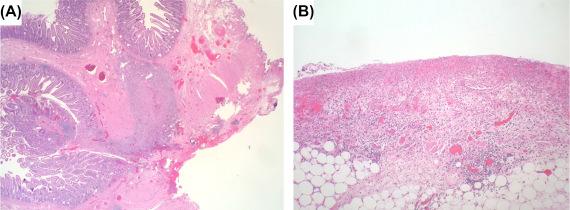
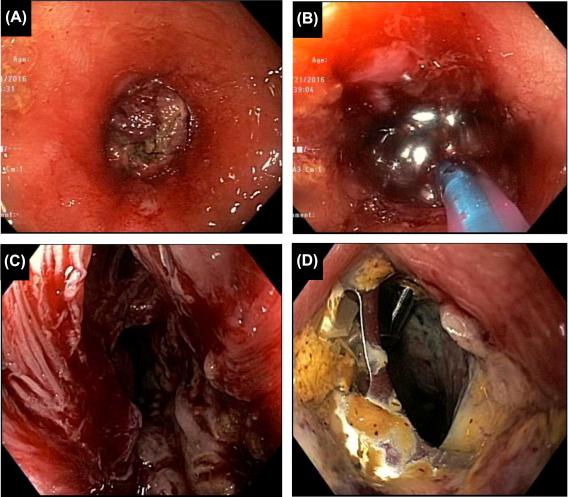
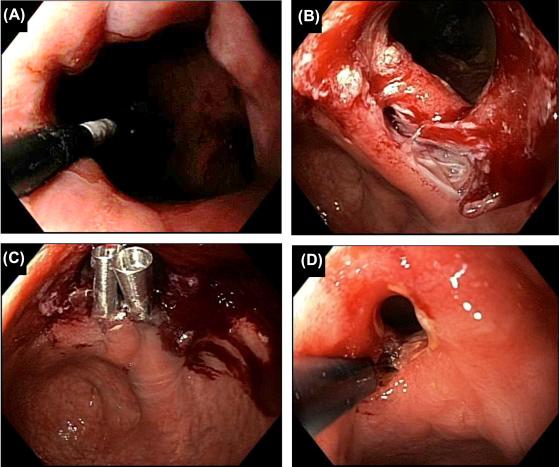
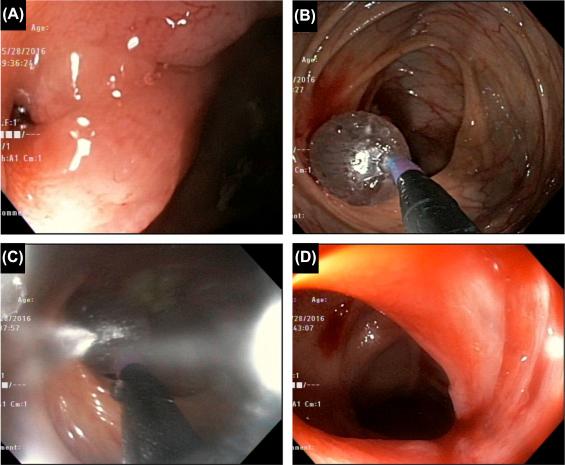

The next critical time for the diagnosis of perforation follows the “30 min role” in the endoscopy recovery room. The index of suspicion should be raised if a patient has excessive pain and bloating, dyspnea, and chills. Stat abdominal imaging is indicated. The alarm for complication is not off even after the patient is discharged from the endoscopy suite. The patient should be closely monitored by him/her-self and family members for at least 24 h. Clear liquid diet is recommended, in case rescuing endoscopy is needed. Late-onset perforation can occur 1–4 days after the procedure, especially when the electrocauterization or electroincision is used. Therefore, patients should be advised to avoid NSAID or anticoagulants and strenuous physical activities for at least 5 days after the endoscopic procedure.
A plain abdominal X-ray is a quick way to diagnose perforation with demonstration of free air under the diaphragm. However, noncontrasted computed tomography (CT) scan is most sensitive modality for the detection of perforation, including demonstration retroperitoneal air which may be missed on plain abdominal radiograph ( Fig. 29.6 ). Another advantage of CT is to detect perforation to the mesentery sheath. For patients with chest pain and back pain who undergo distal large bowel procedure (such as distal rectal or distal ileal pouch stricture, fistula, sinus therapy), retroperitoneal air and pneumomediastinum from perforation is suspected CT chest along with CT abdomen/pelvis is a valuable tool for the diagnosis, although plain chest and abdominal X-ray may be helpful.
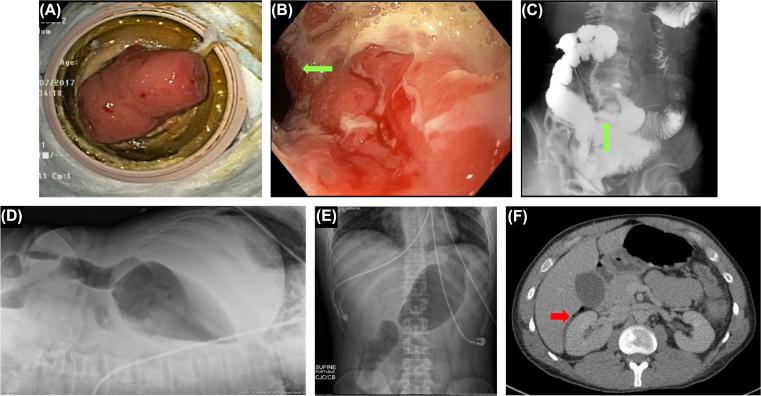
Due to complex anatomy and various forms of diagnostic and therapeutic endoscopy in IBD, there is a wide spectrum of iatrogenic perforations in those patients. Iatrogenic, endoscopy-associated perforation can be classified, based on different criteria ( Table 29.2 ). There are correlations between the criteria. For example, the perforation from blunt trauma from the tip of endoscope or electroincision is often located at the endoscopy-treated site; perforation from the trauma from the shaft of looped endoscope is commonly seen at the segment of bowel distal to the endoscopy-treated area; and the perforation from the tip of forward-slippery balloon is usually seen at the bowel segment proximal to the endoscopy-treated area. There can be blunt trauma, unintended resection, dissection, excision, and thermal injury.
| Criteria | Classification | Subclassification | Comments |
|---|---|---|---|
| Etiology | Disease related | Ulcerative colitis | Fulminant colitis |
| Crohn's disease | Abscess or contained “perforation” far more often than free “perforation” | ||
| IBD postsurgical | Spontaneous leak at the tip of the “J” in ileal pouch | ||
| Iatrogenic | Diagnostic endoscopy | Scope trauma of diagnostic colonoscopy, pouchoscopy, or ileoscopy | |
| Therapeutic endoscopy | Balloon dilation, polypectomy, stricturotomy, endoscopic mucosal resection (EMR) or submucosal dissection | ||
| Enterotomy during surgery | Laparoscopic injury | ||
| Underlying disease | Ulcerative colitis | Inflammatory polyps, dysplastic lesions | |
| Crohn's disease | Primary or anastomotic strictures, fistula, abscess | ||
| Ileal pouch disorders | Pouchitis, pouch stricture, Crohn's disease of the pouch, pouch-vaginal fistula | ||
| Mechanism | Air | Scope | Over insufflation, especially room air |
| Barotrauma | Scope | Tip of shaft of the scope | |
| Device | Balloon tip, balloon body, catheter, injection needles, cold snare, misplaced over-the-scope clips | ||
| Thermal injury | Hot snare, EMR or submucosal dissection, electroincision, electrocauterization | ||
| Onset | Onsite | During procedure | The second look after the initial endoscopic therapy is helpful for the timely diagnosis; the “30 min” role of diagnosis and window period for endoscopic intervention |
| Early onset | Within 24 h after procedure | Endoscopic reintervention may be attempted, in the absence of peritonitis, abscess, or sepsis | |
| Late onset | After 24 h of procedure | Often related to thermal injury or vigorous physical activity after procedure | |
| Degree | Subserosa perforation | Intact serosa and no air leak | |
| Full-thickness perforation without extravasation | Often self-limited with conservative management; | ||
| Full-thickness perforation with extravasation of air, liquid, fecal materials | Surgical intervention often needed | ||
| Full-thickness perforation with peritonitis, abscess, or sepsis | Surgical intervention and likely diverting stoma needed | ||
| Size of perforation | Small ≤1 cm | The best candidate for rescuing endoscopic treatment | |
| Medium 1–2 cm | Surgery often needed | ||
| Large ≥2 cm | Often seen in barotrauma from the scope shaft or esophagus perforation or EMR or submucosal dissection; surgery often needed | ||
| Perforation relevant to mesentery | Mesenteric site | Mesentery abscess, often requiring resection of a long segment of bowel | |
| Antemesenteric site | Free perforation, peritonitis, intraabdominal abscess | ||
| Location | Nonendoscopy-treated area | Nondiseased area | Sigmoid colon perforation common; can be proximal or distal to the treated area |
| Diseased area | Can be proximal or distal to the treated area | ||
| Surgery-altered area (suture line, anastomosis) | Can be proximal or distal to the treated area | ||
| Endoscopy-treated area | Polyp or mass | Snare polypectomy, hot biopsy, EMR, or submucosal dissection | |
| Stricture | Balloon dilation, stricturostomy, sinusotomy | ||
| Fistula | Fistulotomy | ||
| Sinus | Sinusotomy | ||
| Consequences | Acute | Free air | May be managed conservatively in patients, especially those with performed distal bowel and the presence of diverting ostomy |
| Peritonitis | Surgical intervention needed | ||
| Abscess and sepsis | Surgery with diverting stoma needed | ||
| Chronic | Fistula | Endoscopic fistulotomy may be attempted in selected patients | |
| Sinus | Candidate for endoscopic sinosotomy | ||
Colonoscopic perforation has been classified into postpolypectomy syndrome, perforation without leak, perforation with air leak, perforation with fluid leak, and perforation with feces leak, based on the substance of leak; perforation, pneumoperitoneum, and peritonitis, based on the presence and degree of infection. Endoscopic clips and abdominal decompression may be used in patients with postpolypectomy syndrome, perforation with no leak, or perforation with air leak. Patients with air leak, fluid leak, or feces leak is preferably managed surgically.
The onset of perforation of endoscopy-associated perforation in general can occur: (1) <24 h; (2) 24–48 h and (3) >48 h after the procedure. In contrast, therapeutic (e.g., EBD) IBD-associated bowel perforation often occurs and identified within 24 h after the procedure and late-onset onset of perforation is not common. Air or barotrauma-associated perforation normally present earlier than heat-related perforation. This author would like to propose the classification of onset of perforation in IBD endoscopy into: (1) onset; (2) <24 h; and (3) >24 h ( Table 29.2 ).
The common location of endoscopy-associated perforation is different in IBD versus non-IBD patients. The sigmoid colon is the most common location of colonoscopic perforation in general. In contrast, the common locations of IBD-associated colonoscopic perforation vary greatly, largely depending on the location of endoscopic treatment, diseased segment, and surgery-altered segment ( Table 29.2 ).
The degree of peritoneal contamination is determined by multiple factors: (1) quality of bowel preparation; (2) size of perforation; (3) interval between perforation to salvage endoscopic or surgical procedure; (4) size and depth of perforation; and (5) status of underlying disease ( Table 29.2 ).
The depth of perforation in IBD can be up to subserosa, full-thickness perforation, free full-thickness perforation without spillage of fecal materials, full-thickness perforation with contained abscess, perforation with peritonitis ( Table 29.2 ).
There are scant publications on the adverse consequence of endoscopic perforation in IBD patients. We previously studied 84 IBD and non-IBD patients who had endoscopy-associated perforation and reported that 4 (6.9%) died, directly resulting from the procedure-related perforation; 55 (65.5%) had other PAC: 3 (3.5%) underwent total colectomy with diverting ileostomy, 28 (33.3%) had bowel resection, fecal diversion, and secondary anastomosis; and 24 (28.6%) had bowel resection with primary anastomosis. We demonstrated that patients who were taking systemic corticosteroids at the time of lower GI endoscopy had a 13-fold higher likelihood of having PAC (95% confidence interval: 1.3, 1839.7; P = .007). Therefore, endoscopy-associated perforation can bear serious consequences.
The adverse consequence of iatrogenic perforation from EBD can be different between the ones from mesentery side and antemesenteric site ( Fig. 29.7 ). The latter results in free perforation with possible peritonitis, while the former can lead to formation of abscess of the mesentery. Both conditions often require bowel resection. However, the extent and technical difficulty of bowel resection for the treatment of iatrogenic mesentery abscess is greater. Therefore, endoscopist would rather pick the “devil” (antemesentery perforation) than the “evil” (mesentery perforation), if he or she would have a choice. This may be an advantage of endoscopic stricturotomy over EBD, as the endoscopist can have a control of depth and location of electroincision. The endoscopist may be able to tell which side of stricture is the antemesentery site, i.e., opposite wall of linear ulcers, and choose the location to cut.
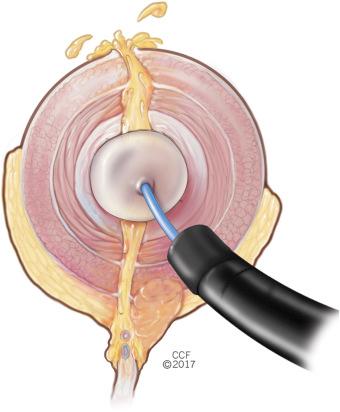
Become a Clinical Tree membership for Full access and enjoy Unlimited articles
If you are a member. Log in here